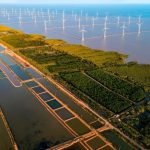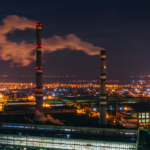Climate change is an urgent problem and a significant challenge for the entire world, and Vietnam is no exception. With the increase in extreme weather events such as floods, droughts, and rising sea levels, Vietnam is often considered one of the most vulnerable countries to climate change. Vietnam’s rapidly growing industry contributes over 20% of the country’s GDP, placing it in a position to face significant challenges from climate change, particularly in the context of an increasingly competitive business environment and growing demands for sustainability.
Global climate change situation
Recent temperature data for Vietnam has revealed a worrying warming trend over the past few decades. With an average increase of about 0.2°C per decade over the past 40 years, the highest increase was observed in the most recent decade. This temperature increase is accompanied by a slight but noticeable increase in annual rainfall, averaging about 5.5% during the same period. However, this rainfall pattern varies significantly depending on different regions of the country.
Additionally, sea levels are rising, posing a major threat to Vietnam’s coastal areas, with an average increase of approximately 3.6 mm per year recorded from 1993 to 2018. To provide a clearer view of these recent climate trends, a carefully constructed new climate dataset has been developed for this report, covering the entire country.
Looking ahead with climate projections, the outlook is concerning. By the end of the century, temperatures are expected to rise by about 1.3°C under a low greenhouse gas emissions scenario (RCP2.6). However, under a high emissions scenario (RCP8.5), this increase could reach around 4.2°C. Moreover, projections indicate that these temperature increases will be more pronounced in the country’s northern regions than in the southern areas.
Beyond temperature increases, projections also suggest changes in rainfall patterns across different regions of Vietnam. While total annual rainfall is expected to increase in most areas, seasonal distribution is anticipated to change. These projections result from using a bias-correction technique to improve the spatial resolution of forecasts from global climate models.
With these new bias-corrected data, stakeholders and policymakers can better understand and measure expected changes in climate variables such as temperature and rainfall across Vietnam’s diverse geographical regions. This enhanced understanding is crucial for developing effective strategies to mitigate the impacts of climate change and adapt to changing environmental conditions in the country.
Negative impacts of climate change
The ongoing increase in average temperatures, sea levels, the frequency of natural disasters, and greenhouse gas emissions negatively impact Vietnam’s industry. These changes are causing serious consequences for the economy in general and Vietnam’s industrial sector.
- Increased natural disaster risks: The frequency and intensity of natural disasters such as floods, droughts, and landslides directly affects industrial production activities.
- Water scarcity: Impacts industries that rely heavily on water, such as hydropower, textiles, and food processing.
- Energy impact: Affects energy supply, especially renewable energy sources like hydropower and solar energy.
- Rising production costs: Increases production costs due to investments in disaster prevention measures, efficient energy use, and climate resilience.
- Reduced competitiveness: Impacts the competitiveness of Vietnam’s industry compared to other countries in the region and worldwide.
Solutions for the industry in response to climate change
To address the major challenges posed by climate change, the industry has implemented and continues to implement several solutions:
- Enhanced application of science and technology: Utilizing science and technology in production to improve the efficiency of energy, water, and natural resource use.
- Development of renewable energy: Developing renewable energy sources such as solar and wind to reduce dependence on fossil fuels.
- Raising Environmental Awareness: Raising awareness among businesses and workers about environmental protection and reducing greenhouse gas emissions.
- Strengthening international cooperation: Collaborating internationally in research, scientific technology application, experience sharing, and resource pooling to respond to climate change.
With comprehensive and decisive solutions, the industry can mitigate the impacts of climate change and ensure sustainable development in the future.
Climate change is a significant challenge and an opportunity for Vietnam’s industry to innovate and develop sustainably. With the government’s determination, the efforts of businesses, and the people’s support, the industry will overcome the challenges posed by climate change and continue to thrive in the future.






